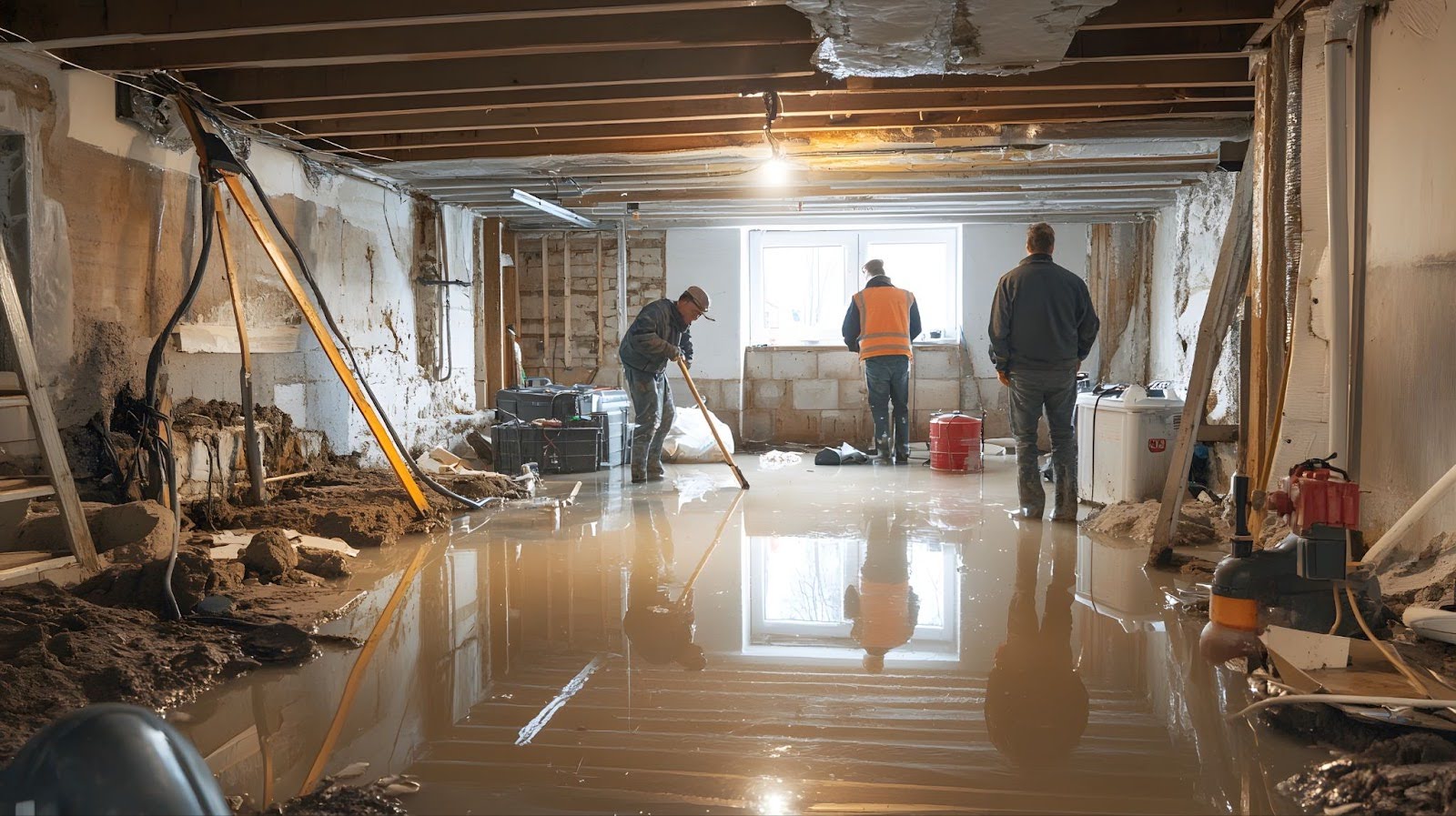A flooded basement can be a property owner’s worst nightmare, leading to water damage, mold growth, and hugely expensive repairs. What’s more, it happens more often than you might imagine.
The chief causes are heavy rain leading to flooding through basement water leaks, although plumbing failures and drainage issues are also likely causes. Either way, knowing what to do when your basement floods from rain may help you minimize damage and restore your space.
This guide will discuss how to fix basement flooding, how to dry out the area safely, and preventative measures to help prevent basement flooding from happening again. Acting quickly after emergency basement flooding can make a major difference in protecting your home and belongings.
Is It Common for Basements to Flood?
Basement flooding can be common, depending on the region and climate. In areas that experience heavy rainfall or even snowmelt from nearby mountains, basement flooding can occur more often. Other causes of emergency basement flooding include faulty sump pumps, inadequate drainage systems, or plumbing problems.
The first step in knowing what to do when a basement floods is to be proactive and informed. Knowing the main reasons for emergency basement flooding may help protect you from dealing with the issue in the first place.
To that end, let’s take a look at a more detailed view of some of the main causes of an emergency basement flood:
Causes Of Flood In Basements
- Defective sump pumps.
- Inadequate drainage systems.
- Plumbing issues, such as burst or leaking pipes.
- Intense rainfall or snowmelt from nearby hills.
- Broken basement windows.
- Obstinate window wells.
- Sewer system problems.
- Unsealed basement walls.
- House positioned at the foot of an incline.
- House located near a natural water source.
- Blocked weeping tiles.
- Overburdened rain gutters
- Misplaced downspouts
- Appliance leaks
- Overflowing toilet or bathtub
- Drainage system failure
- Water heater breakdown
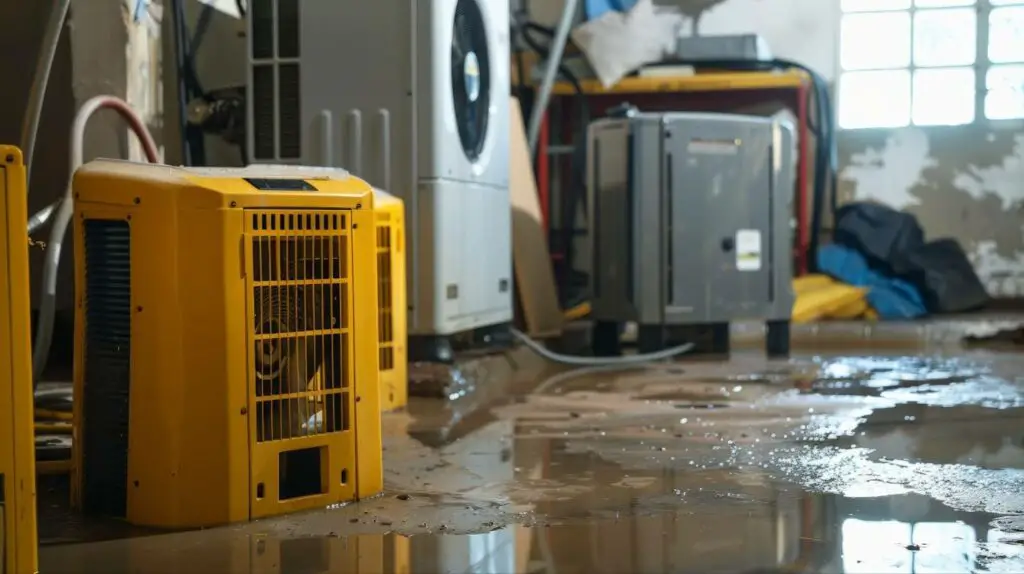
Basement Flooded: What to Do
Being aware of the main causes is a significant step in protecting yourself from potential flood damage repair, but what to do when the basement floods in practical terms? If you are faced with emergency basement flooding, there are several steps you should take to protect yourself and your property:
Assess the Situation
Attempt to identify the cause of the emergency basement flooding, the type of water, and determine if it is safe to stay in the area.
Call Your Insurance Company and Take Pictures
Contact your insurance company as soon as possible after a basement has flooded and take pictures of the damage for evidence before beginning repair or cleanup efforts.
Protect Yourself
When entering a flooded area, wear protective clothing, such as rubber boots, hard hats, and goggles. Also, be aware of potential hazards, such as electrical wiring or hazardous materials, that may be present during emergency basement flooding.
Turn Off the Power
To avoid an electrical shock, turn off the power and unplug all appliances and electronic devices if your circuit breaker is not located in the basement.
Remove All Damaged Materials, Furniture, and Excess Water
After assessing the area’s safety, begin removing all items damaged by the flooding, including carpets and furniture that have been soaked with water. If possible, use a sump pump to remove any standing water from the area before beginning clean-up efforts.
Increase Air Circulation
After flood waters recede, open windows or bring in fans to help reduce humidity levels, speed up drying times for walls and floors and remove any lingering odors caused by the emergency basement flooding.
Start the Drying Process
Use towels, floor drains, or mops on non-porous surfaces like concrete floors or tile walls to absorb moisture quickly. Also, make sure vents are open for air circulation throughout a basement area so wet areas can dry more quickly.
Clean the Area and Disinfect
Thoroughly clean affected areas with a soap or detergent solution. Then, mix one cup of bleach with two gallons of water to disinfect the area; do not mix different cleaning products while cleaning surfaces after an emergency basement flooding, as this can create hazardous fumes.
Repair Pipes, Foundation, and Flooring
So, what to do when the basement floods in terms of fixed construction? Emergency basement flooding repair includes checking all plumbing lines leading into a basement for cracks or breaks, repairing burst pipes, and inspecting foundation walls for signs of water damage, such as efflorescence or white deposits.
If needed, replace the carpet pad that exposed dampness (due to its porous nature), then follow up with professional repair of any structural damage if necessary before completely restoring an affected room to ensure proper stabilization during future storms.
Check for Mold
Check carefully near corners of ceilings or window frames where condensation tends to accumulate over time, forming bacteria known commonly as mold. Look for any visible signs of blackening caused by excessive moisture left behind by the emergency basement flooding.
If necessary, hire a professional service to clean the affected areas thoroughly to prevent further health risks. Without professional assistance, occupants could potentially experience allergic reactions to specific types of mold or possibly face more serious health issues.
Keep an Eye on Your Basement
After all the steps are completed, it’s important to monitor your basement over time for any signs of water damage. If you’ve ever found your basement flooded, what to do next becomes just as important as the initial cleanup. Addressing minor problems quickly can help reduce the chances of larger issues such as mold or structural instability.
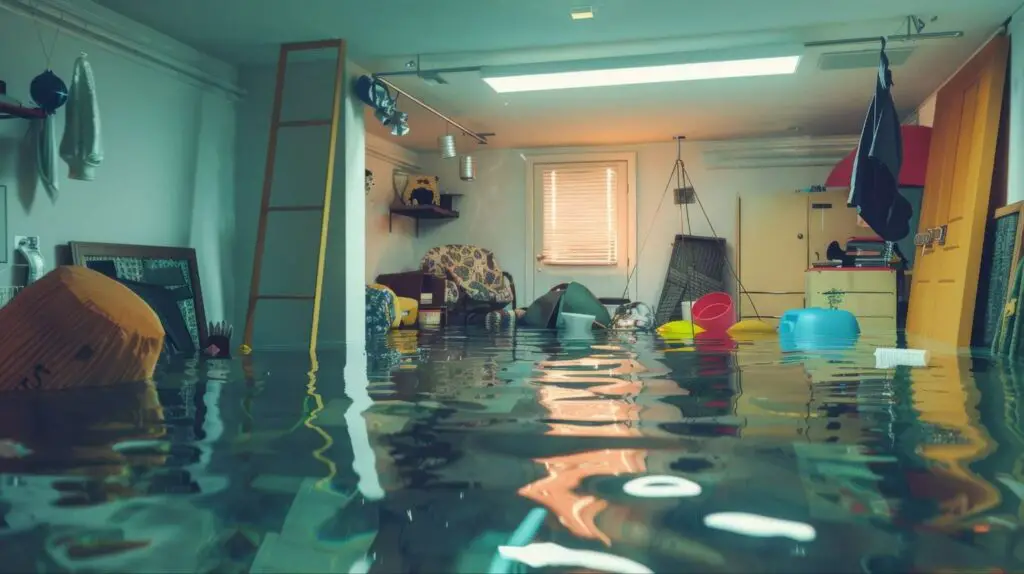
What Not to Do When Basement Floods
When dealing with an emergency basement flooding, there are a few steps you should be mindful of avoiding:
- Do not enter the area if it is deemed unsafe.
- Do not use electrical appliances near a flooded area unless they have been properly inspected and certified safe.
- Do not mix different cleaning products when cleaning surfaces after they have been flooded, as this can create hazardous fumes.
- Do not attempt to repair pipes or foundation damage without professional help. There may be unseen issues that could cause further damage to your property.
- Do not skip any of the drying and disinfecting stages listed above, as leaving behind moisture or uncleaned areas could lead to mold growth in the future.
How to Clean My Basement After Flooding?
The following steps will help you in your emergency basement flooding cleanup process:
- Remove any standing water: If you can do so safely, use a sump pump to remove all water from the area and dry out the space with fans or by opening windows.
- Clean and disinfect surfaces: To clean surfaces in the basement and reduce bacteria and fungus growth, use a mixture of one cup of bleach per two gallons of water.
- Remove any damaged materials: If carpets, furniture, or other items are soaked with floodwater, throw them away. They may contain mold spores or dangerous chemicals that could be hazardous to your health.
- Clean any remaining walls and floors: Vacuum out any dirt or debris left behind on porous surfaces like carpeting, tile walls, concrete floors, etc. Also, scrub down all surfaces with a cleaning agent specifically designed for basements, such as mildew-resistant paint.
- Deodorize the basement: After cleaning up the area, use an odor remover product to remove unpleasant odors and keep the air quality in your home safe and clean for occupants. If you’re still detecting a foul odor in your basement, it’s best to consult a professional. Chances are there’s either mold or moisture still lingering down there that needs to be taken care of.
- Inspect for mold: Inspect the edges of your ceilings and window frames for any signs of blackening, as this is usually indicative of mold after water damage. Additionally, evaluate if there are any discolorations on your walls or crevices behind the paneling due to flooding events in the area.
How Long Does It Take for a Flooded Basement to Dry Out?
The time it takes for an emergency basement flooding to dry out depends on many factors, including the size of the basement, the amount of water that has been removed, and the air circulation and temperature levels inside the space. Generally speaking, if enough water is removed from the area, it could take anywhere from 24 to 72 hours for your basement to dry after a flood.
The drying process can be done in several ways. The most common methods of water removal from an emergency basement flooding include using a sump pump, wet/dry vacuum cleaner, dehumidifier, fans, and natural evaporation.
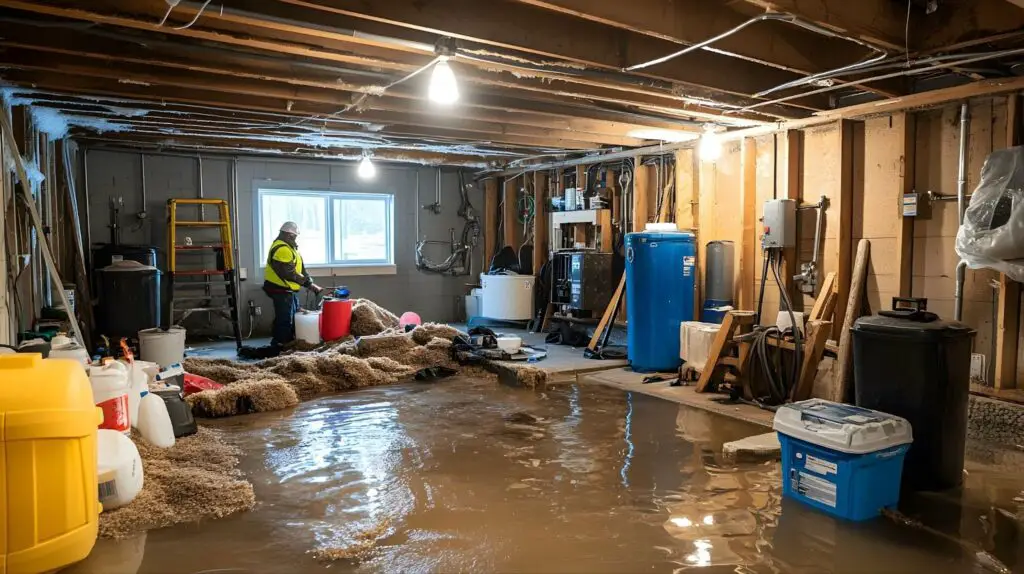
- Sump Pumps: This is one of the quickest ways to remove water from a flooded basement. It can take anywhere from 30 minutes to an hour for all of the standing water to be pumped out. However, some areas may require multiple attempts before wet spots are completely removed from carpets and other areas.
- Air Circulation: Opening windows can help dry out your basement faster, but how to fix basement flooding with natural evaporation really depends on the weather. Warmer climates speed up drying, while cooler conditions tend to slow it down. Check the forecast before relying on this method, as it can usually take 3 to 7 days based on temperature and humidity.
- Heaters and Dehumidifiers: Using heaters and dehumidifiers can speed up drying, usually taking 2 to 4 days. Proper ventilation is key to keeping moisture levels low and maintaining the warmth needed for effective evaporation. Regular maintenance ensures these tools work efficiently.
- Fans: Fans can speed up drying by 30-50%, but they depend on natural air circulation. If you’re dealing with emergency basement flooding, fans can reduce flooding moisture in 12-24 hours, but additional methods may be needed for thorough drying.
- Wet/Dry Vacuum Cleaner: It can also be used to pump up any standing water in hard-to-reach places that manual mopping cannot access. Pumping away all the excess water with this method typically takes two hours or more, depending on the scale of the emergency basement flooding.
How to Prevent Basement Flood?
While knowing what to do when your basement floods from rain (or any other cause) is important, ultimately, prevention is a much wiser approach to the problem.
Stopping emergency basement flooding from happening in the first place should be an obvious priority for any homeowner. Here are some tips to help you prevent basement flooding:
- Check Gutters and Downspouts: Clearing leaves, sticks, and debris will help channel water away from your home. Additionally, check the downspouts are correctly connected to the drainpipes so water isn’t flowing directly onto the foundation walls or near the basement windows.
- Check for Cracks in Your Foundation: Inspect your foundation regularly for any cracks that may be allowing water into your basement. If you do find any, have them sealed as soon as possible.
- Check Your Basement Floor Drain: Make sure it’s clear of debris and has no blockages that could cause a backup of water into your basement. It’s best to carry out regular inspections on the floor drain and make sure it’s working properly.
- Seal Basement Windows: If you have windows in your basement, seal points where air transfers can occur, such as around window frames or seals with waterproof caulking or expandable foam spray.
- Sump Pump: Sump pumps are designed to collect any excess water that enters the basement through drainage systems or heavy rainfall and pump it back outside where it can be safely disposed of.
- Get Your Septic Tank Pumped Regularly: Having an overflowing tank can cause flooding and water damage, so ensure this doesn’t happen by scheduling regular visits from professionals who can take care of this task for you.
- Regular Sewer Inspections: Sewers should be inspected periodically, as roots from nearby trees can crack pipes, causing further damage if left unresolved.
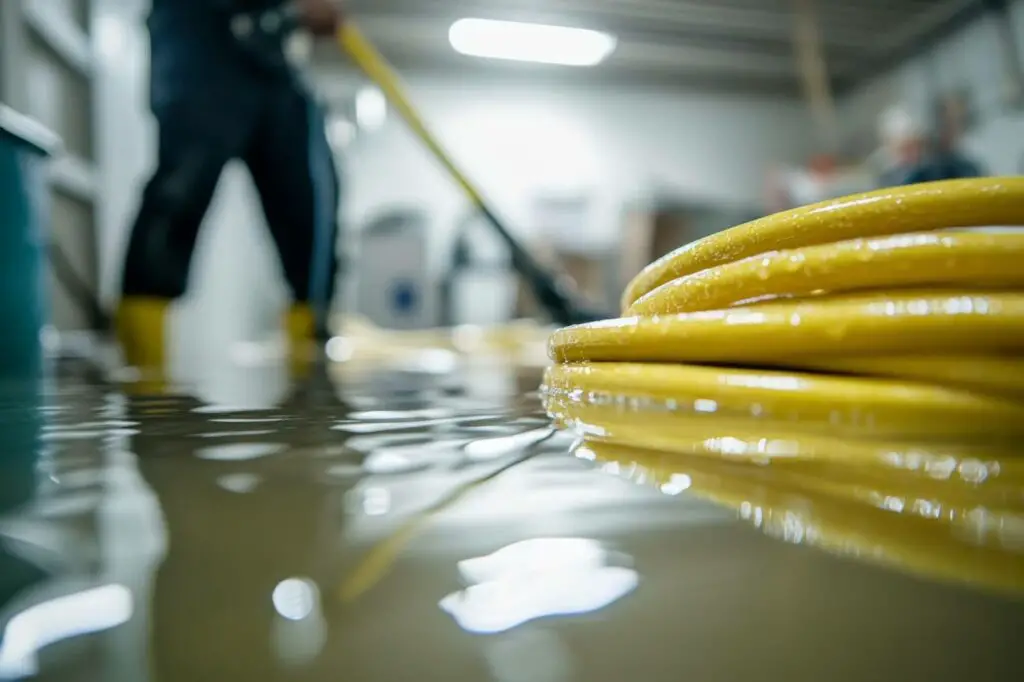
Does Insurance Cover Flooded Basements?
Insurance does not typically cover damage from floods, but it can be possible to include flood insurance in your existing policy for an additional cost. Flood insurance provides coverage for any property damage caused by rising waters, such as those from rivers, streams, or lakes. It also covers any water damage resulting from sewer backups or heavy rains.
To determine if you are eligible for flood insurance, speak with an experienced professional who can review your policy and explain your coverage options.
Understanding what to do when your basement floods from rain includes knowing whether your insurance covers water damage. A professional can provide a quote based on your location, helping you assess your protection and costs.
If you are looking for protection against flooding caused by storms and hurricanes, you may need a separate policy called ‘flood surge insurance.’ This covers damage from sudden water level rises caused by severe weather. If your basement flooded, what to do next may include checking whether your insurance policy covers storm-related flooding. Rates vary by location, so always consult an expert before deciding.
Bottom Line
If you experience a burst pipe or your basement floods, it’s best to get professional help immediately. If left unattended, the situation can quickly become unmanageable. A professional contractor, such as Wet Reset, can diagnose and fix any issues with the pipes and help with repairs to make your basement safe again.
We can also help assess the damage to estimate how much work is required to return your basement to its former condition, from replacing flooring, walls, and ceiling materials affected by water damage to providing expert advice on how best to prevent future basement flooding.
Are you facing emergency basement flooding? Call Wet Reset today – our 24/7 water damage repair service will restore your basement quickly and prevent further damage!
FAQs
What to do when your basement floods from rain?
Shut off the power, remove the water, and dry the space with fans and dehumidifiers. Address drainage issues to prevent future flooding.
The basement is flooded, what to do first?
Ensure safety, turn off electricity if needed, and remove standing water. Call a professional if the damage is severe.
What to do when the basement floods unexpectedly?
Identify the cause, document damage for insurance, and start drying immediately to prevent mold and structural issues.
How to fix basement flooding long-term?
Install a sump pump, improve drainage, and seal cracks to keep water out. Routine maintenance helps prevent future floods.
How do you handle emergency basement flooding?
If you experience severe flooding, call a 24/7 water damage service to remove the water, dry the area, and repair structural damage quickly.

